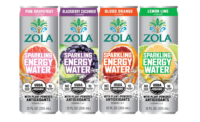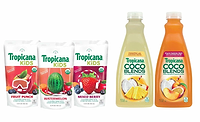Domestic and exotic fruits bring health benefits, flavor
Fruits used in non-alcohol and alcohol products

As health, nutrition and clean label remain key drivers in guiding innovation within the beverage industry, consumers are looking for functional beverages that deliver benefits like immune health, vitamin support and promote overall well-being. Recognizable domestic fruits like raspberry, watermelon, mango and coconut are adding natural flavors and colors to many products, while exotic fruits like acerola and dragon fruit are emerging on the beverage scene.
Kristen Farr, marketing and innovation manager for Lawrenceville, N.J.-based iTi Tropicals, notes several trends that are encouraging the use of domestic and exotic fruits within beverages. These include the rise of better-for-you functional beverages; the popularity of fermented beverages like kombucha, drinking vinegars and other probiotic-enhanced drinks; cold-pressed juices; and high-pressure processing (HPP) technology.
“Better-for-you functional beverages that deliver health benefits, carbonated/sparkling water, iced tea with fruit, maple water and cactus water [are impacting the use of domestic and exotic fruits],” Farr explains. “Cold-pressed juices and HPP technology have helped to drive tropical fruit flavors since they complement the minimal processing and provide bright flavor profiles.
“Consumers are looking for beverages to give them energy and have a positive impact on their health,” Farr continues. “With botanical flavors also becoming more popular, fruits are often paired with more unfamiliar and floral flavors like chamomile, ginger, hibiscus and green tea. The popularity of sophisticated herbal and floral flavors is being driven in large part [by] consumers’ desire to drink less alcohol and are turning to mocktails and non-alcoholic beverages like tea.”
Tom Payne, industry consultant to the U.S. Highbush Blueberry Council, San Mateo, Calif., points to the “beverage for breakfast” trend as being a good platform for the across-the-board, clean-label appeal of blueberries.
“Beverages for breakfast is a major growth trend with consumers who want a fast and easy way to eat breakfast,” he says. “Easily consumed drinkable breakfasts, which include blueberries, provide an abundance of nutrients as well as the delicious taste of lush, sweet blueberries in the form of smoothies, juices, teas, sports and energy drinks.”
When it comes to sourcing fruit ingredients, many beverage companies are focusing on regional trends depending on their location, says Al Murphy, vice president of flavors for alcohol at Mother Murphy’s, Greensboro, N.C.
“For example, in Louisiana, the Satsuma fruit is a popular regional fruit. Bayou Rum has created a rum brand using Satsuma, which is a domestic fruit,” Al Murphy says.
A fruity flair
Pineapple, mango, passionfruit, dragon fruit, blueberries, acerola, lychee, mangosteen, star fruit, prickly pear, pomegranate and jack fruit are among the domestic and exotic fruits that beverage-makers are using to add taste and flavor to non-alcohol and alcohol beverages, experts note.
Due to the slowdown of the craft fermented beverage category, brewers and hard cider makers are turning to fruit as a go-to choice for inspiration and innovation, says Chris Hodge, director of sales for brewing at Oregon Fruit Products, Salem, Ore.
“For brewing, red raspberry is our No. 1 selling fruit puree,” Hodge says. “However, the tropical fruits have grown exponentially in popularity in the past few years. Oregon Fruit began sourcing more exotic fruit like mango, pineapple, passionfruit and pink guava a few years ago to offer up some purees on a limited quarterly basis. Each flavor has now become a year-round offering, with mango and pineapple now in our Top 10 best sellers.”
The rise in popularity of ethnic food, both in restaurants and home cooking, has led to an increased use of tropical fruits to complement more assertive flavors, Hodge says. “Tropical fruits … are refreshing and cleansing to the palate and even offer a little heat relief from the spicier foods,” he adds.
Hodge highlights that many “old school” fruits like black currant, plum, boysenberry and cranberry are seeing a resurgence in interest by offering not only nostalgia, but also aroma and flavor. “They’re also an attractive option for those beverage-makers looking for more affordable, domestic flavors than imported fruits,” he says.
From baby boomers to millennials, non-artificial ingredients are sought after by consumers who also appreciate the health benefits that many of these fruits offer. For instance, many beverage companies are touting the health benefits of watermelon, Mother Murphy’s Al Murphy says.
“Watermelon is known to lower blood pressure and contain a high degree of antioxidants,” he explains. “Citrulline, which is found in watermelon, is known to enable blood vessels to stay relaxed, which in turn, increases blood flow.”
The universal usage and benefits of mango also can be seen throughout the beverage market, iTi Tropicals' Farr notes. “[M]ango is showing up in refrigerator cases, cocktail menus and even in tea,” she says. “It is a bright, sweet flavor that has [the] health benefits of vitamins A, C and E.”
Known as the Barbados cherry, acerola is an emerging exotic fruit that offers a clean-label source of vitamin C “with a deliciously tart taste,” while passionfruit’s sweet, yet tart flavor pairs nicely with more familiar fruits like apple and grape, Farr says.
Formulation options
As beverage-makers utilize domestic and exotic fruits, experts highlight the versatility of these ingredients. The U.S. Highbush Blueberry Council’s Payne notes that blueberries are synergistic with herbs, spices and many other flavors, including ginger, cocoa, chocolate caramel and lemonade. They also can be used to provide antioxidants in teas, juice drinks, wheat beers, wines, vodkas, gins and culinary cocktails.
When making the decision to formulate with domestic and exotic fruits, Oregon Fruit Products’ Hodge suggests beverage-makers take the time to do small-scale, benchtop versions of any new fruit-infused recipes. “Also, build in market fluctuations for fruit into your costing model,” he says. “One of the reasons why we developed a shelf-stable fruit puree was that our customers could get consistent fruit flavor, texture, quality and availability.”
Additionally, tropical fruit juices used in combination with commoditized fruits allows for value-added benefits, iTi’s Farr says. “Banana, for example, is very low cost and a tremendous asset in building beverages and smoothies from a mouthfeel standpoint. Overall, cost is only one aspect. Quality, safety and making a product consumers will buy and love are the most important,” she says.
New fruits and flavors will continue to resonate in the beverage industry, particularly as the millennial generation spends money on experiences including travel, food and beverages, Mother Murphy’s Al Murphy says.
“As more young people are exposed to international flavor profiles, then we will continue to see more of a demand for exotic flavors. … On my recent trip to Mongolia, I was able to try sea buckhorn, which is stepped in hot water during the winter,” Murphy says. “… I was told by the local people that sea buckhorn has 15 times more vitamin C than what you receive within an orange. The berry is known for its potent antioxidant activity and many other health benefits.
“Most people have probably never heard of sea buckhorn, but maybe one day we will see the berry used in a domestic beverage within the U.S.,” he adds. BI
Looking for a reprint of this article?
From high-res PDFs to custom plaques, order your copy today!






